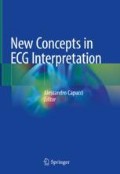Abstract
PR interval (measured from the initial P wave to the beginning of the QRS complex) reflects the time needed for an electrical impulse to be transmitted from the sinus node to the ventricles, so it is an integration of informations about different sites of the conduction system of the heart. To find a PR interval out of normal limits is not always a benign condition as previously believed. PR prolongation may not only underlie a major conduction disturbance (as in case 2), but it has also been related to the risk of atrial fibrillation (as in case 1); furthermore it may reflect different electrophysiological abnormalities, including atrial enlargement. A short PR interval instead has been shown to be an AF predictor and is linked to higher incidence of ischemic heart disease (as in case 3).
Access this chapter
Tax calculation will be finalised at checkout
Purchases are for personal use only
References
Dilaveris PE, Farbom P, Batchvarov V, et al. Circadian behavior of P-wave duration, P-wave area, and PR interval in healthy subjects. Ann Noninvasive Electrocardiol. 2001;6(2):92–7.
Josephson ME. Clinical cardiac electrophysiology. 4th ed. Philadelphia: Lippincott Williams & Wilkins; 2008. p. 93–113.
Kwok CS, Rashid M, Beynon R, et al. Prolonged PR interval, first-degree heart block and adverse cardiovascular outcomes: a systematic review and meta-analysis. Heart. 2016;102(9):672–80.
Cheng M, Lu X, Huang J, et al. Electrocardiographic PR prolongation and atrial fibrillation risk: a meta-analysis of prospective cohort studies. J Cardiovasc Electrophysiol. 2015;26(1):36–41.
Nielsen JB, Pietersen A, Graff C, et al. Risk of atrial fibrillation as a function of the electrocardiographic PR interval: results from the Copenhagen ECG Study. Heart Rhythm. 2013;10(9):1249–56.
Iwasaki Y, Nishida K, Kato T, et al. Atrial fibrillation pathophysiology: implications for management. Circulation. 2011;124(20):2264–74.
Chan Y, Siu C, Yiu K, et al. Prolongation of PR interval is associated with endothelial dysfunction and activation of vascular repair in high-risk cardiovascular patients. J Interv Card Electrophysiol. 2013;37(1):55–61.
Aro AL, Anttonen O, Kerola T, et al. Prognostic significance of prolonged PR interval in the general population. Eur Heart J. 2014;35(2):123–9.
Perez MV, Dewey FE, Marcus R, et al. Electrocardiographic predictors of atrial fibrillation. Am Heart J. 2009;158(4):622–8.
Okutucu S, Aytemir K, Oto A. P-wave dispersion: what we know till now? JRSM Cardiovasc Dis. 2016;5:1–9.
Holmqvist F, et al. Clinical outcome as a function of the PR-interval- there is virtue in moderation: data from the Duke Databank for cardiovascular disease. Europace. 2015;17:978–85.
Issa ZF, Miller JM, Zipes DP. Clinical arrhythmology and electrophysiology: a companion to Braunwald’s heart disease. 2nd ed. Philadelphia: Saunders Elsevier; 2009.
Waller BF, Gering LE, Branyas NA, et al. Anatomy, histology and pathology of the cardiac conduction system-part V. Clin Cardiol. 1993;16:565–9.
De Jong S, van Veen TAB, van Rijen HVM, et al. Fibrosis and cardiac arrhythmias. J Cardiovasc Pharmacol. 2011;57:630–8.
Rasmussen PV, et al. Electrocardiographic PR-interval duration and cardiovascular risk: results from the Copenhagen ECG study. Can J Cardiol. 2017;33(5):674–81. https://doi.org/10.1016/j.cjca.2017.02.015.
Cheng S, Keyes MJ, et al. Long-term outcomes in individuals with prolonged PR interval or first-degree atrioventricular block. JAMA. 2009;301(24):2571–7.
Crisel RK, Farzaneh-Far R, Na B, et al. First-degree atrioventricular block is associated with heart failure and death in persons with stable coronary artery disease: data from the Heart and Soul study. Eur Heart J. 2011;32(15):1875–80.
Magnani JW, Wang N, Nelson KP, et al. Electrocardiographic PR interval and adverse outcomes in older adults: the health, aging, and body composition study. Circ Arrhythm Electrophysiol. 2013;6(1):84–90.
Knuiman M, Briffa T, et al. A cohort study examination of established and emerging risk factors for atrial fibrillation: the Busselton Health Study. Eur J Epidemiol. 2014;29(3):181–90.
Kobayashi T, Watanabe M, Kokubo Y, et al. Prolonged PR interval is significantly associated with increased risk of cardiovascular diseases and stroke in a population-based cohort study. Circulation. 2014;130:A13451.
Uhm JS, Shim J, et al. First-degree atrioventricular block is associated with advanced atrioventricular block, atrial fibrillation and left ventricular dysfunction in patients with hypertension. J Hypertens. 2104;32(5):1115–20.
Author information
Authors and Affiliations
Editor information
Editors and Affiliations
Rights and permissions
Copyright information
© 2019 Springer Nature Switzerland AG
About this chapter
Cite this chapter
Cesini, S., D’Agostino, S., Patani, F., Troiano, F. (2019). PR Segment: Cardiac Implications. In: Capucci, A. (eds) New Concepts in ECG Interpretation. Springer, Cham. https://doi.org/10.1007/978-3-319-91677-4_3
Download citation
DOI: https://doi.org/10.1007/978-3-319-91677-4_3
Published:
Publisher Name: Springer, Cham
Print ISBN: 978-3-319-91676-7
Online ISBN: 978-3-319-91677-4
eBook Packages: MedicineMedicine (R0)

